Have you ever sent a support message, watched the “typing…” bubble disappear, and started wondering if anyone was actually on the other side?
I’ve been there — both as a frustrated customer and as someone trying to manage incoming tickets that never seem to stop. In those moments, response time becomes more than just a metric; it’s a reflection of how much a brand values its customers.
In 2025, that reflection has never been sharper. The rise of AI chatbots, real-time messaging, and global support teams has made “instant” the new normal — and customers are quick to notice when brands fall behind. In this post, I’ll share what I’ve learned about how expectations around response times are evolving, what “fast enough” really means across channels, and how businesses can balance AI speed with human empathy to meet (and exceed) modern expectations.
Quick Summary by LiveChatAI
If you only have a minute, here’s what this post covers:
- 🧭 The “speed expectation shift” — how customer patience is shrinking and why response time is now a loyalty metric.
- 💬 Channel-by-channel insights — what “fast enough” means for email, chat, social media, and voice support in 2025.
- 📊 Reality check — how actual response times compare to what customers expect, and where industries are falling short.
- 🤖 AI vs. human responsiveness — how automation helps teams deliver instant replies without sacrificing empathy.
- ⚙️ Best practices that work — from setting clear SLAs to using smart triage and hybrid human+AI workflows.
- 🔮 The future of response time — how predictive support, LLMs, and proactive outreach are redefining “instant.”
By the end, you’ll have a clear sense of what customers really expect this year — and the practical steps to make sure your team keeps up.
Why Response Time Matters in 2025
The Rising Expectations of Modern Customers
In my experience, what customers expect from support has shifted dramatically over the past few years. It’s no longer acceptable to say “we’ll get back to you in 24 hours” and assume people will wait patiently. Today, time is one of the strongest currencies we deal in — and response time is one of the clearest signals a company gives about how much it values its customers.
Here are a few observations (backed by data) that help explain why expectations have changed so fast:
- Shrinking tolerance windows. Over 50% of consumers now expect a brand to respond to their inquiries within an hour. (Thematic)
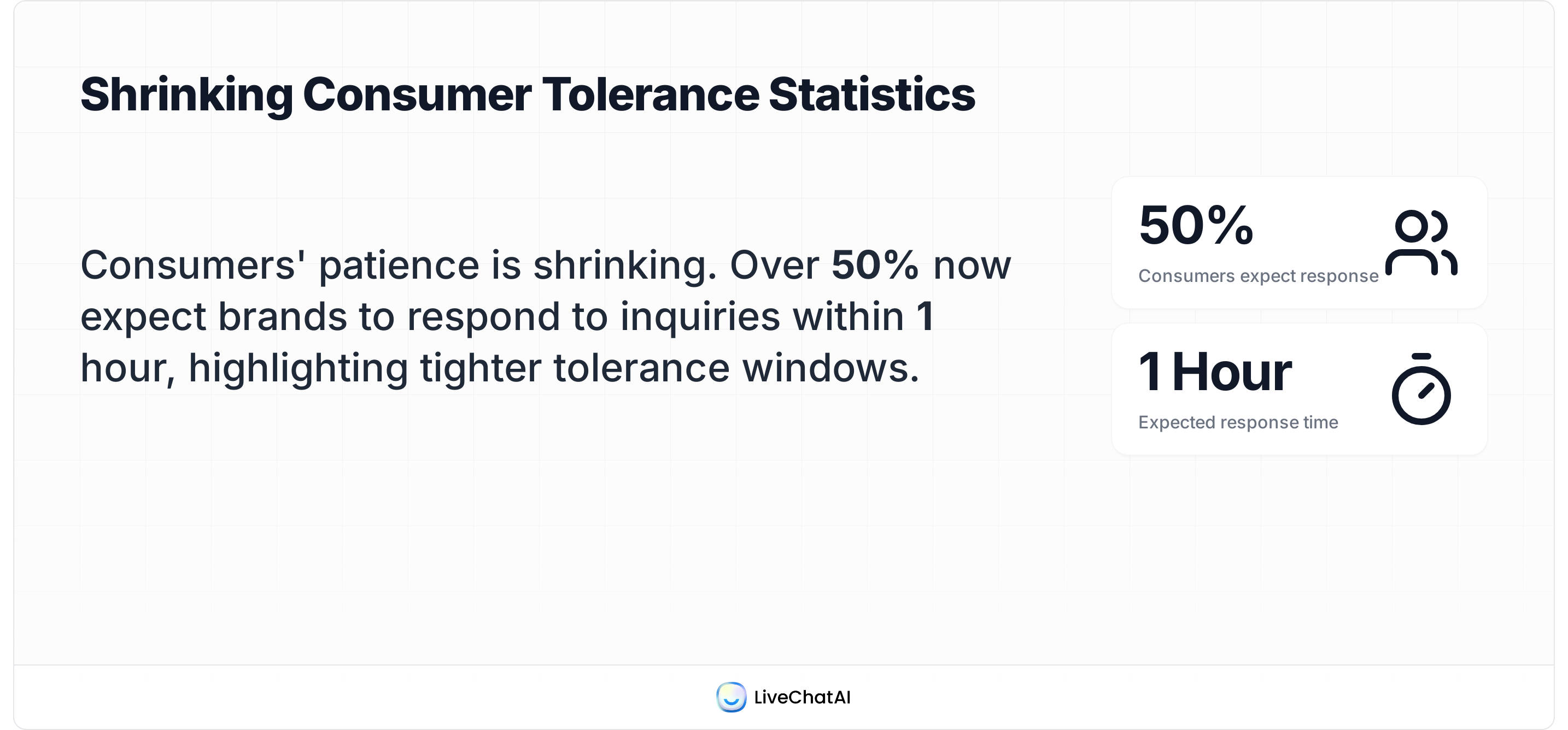
- Instant as a baseline, not a bonus. Many customers view “instant” (or near-instant) as the standard, especially when interacting via chat, social, or messaging. The moment your reply is delayed, you risk losing perceived value.
- Cross-industry comparisons raise the bar. A customer comparing Netflix, Amazon, or a fintech app will expect that same level of responsiveness from a clothing brand, SaaS tool, or bank. The “best experience ever had” becomes the benchmark.
- Psychological impact of waiting. Even a short wait can cause frustration before the issue is resolved. The perceived delay — the feeling of being ignored — often matters more than the actual delay.
- Generational and cultural shifts. Younger demographics and mobile-first audiences are more accustomed to real-time interaction (messaging, chat, social). They may have lower tolerance for delays than older segments.
Because of this shift, response time has become not just a support metric, but a brand promise. Brands that consistently respond quickly gain reputational benefits; those that don’t risk being seen as slow, unresponsive, or uncaring.
The Business Cost of Slow Support
I think one of the most powerful ways to convince stakeholders to prioritize speed is to show them just how costly delay can be — financially, reputationally, and strategically. Here’s what I’ve found in my research and experience:
- Lost revenue & customer churn.
A study from the Qualtrics XM Institute estimates that U.S. businesses risk losing $856 billion annually because of poor customer service. (NJBIA)
Globally, poor service (which includes slow response) puts $3.7 trillion of revenue at risk. (Zendesk) - Brand abandonment & switching.
According to benchmark data, more than half of consumers will switch to a competitor after a single bad experience. (Zendesk)
Further, many customers don’t complain — they silently leave. A slow reply or no reply might not spark a call or complaint, but it can drive quiet attrition. (Zendesk)
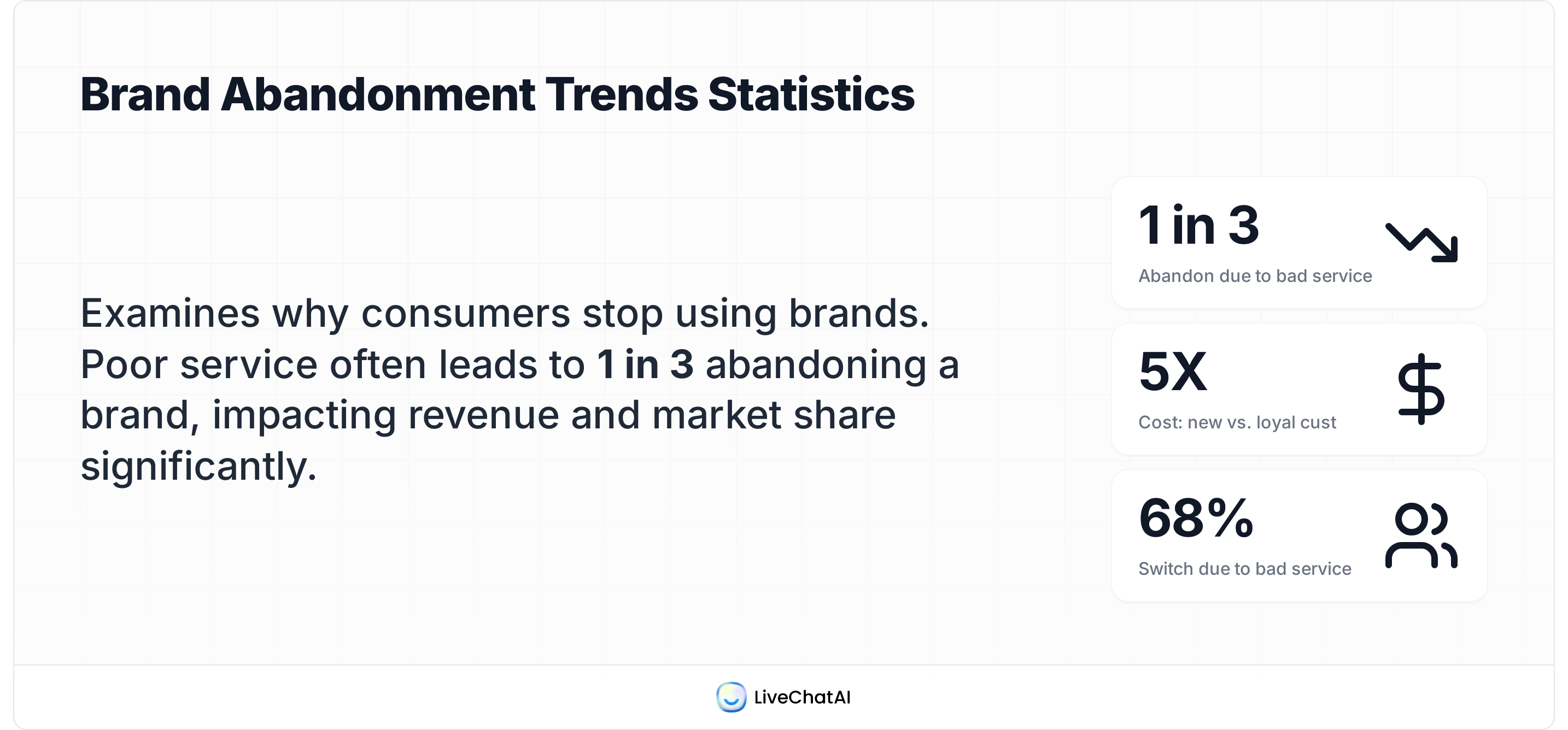
- Opportunity cost of poor CX.
Companies that lead in customer experience often grow revenue 80% faster than their peers. (SuperOffice)
Also, 86% of buyers say they’ll pay more for a better experience. - Efficiency & resource waste.
When issues linger longer, support teams tie up more time handling follow-ups, escalations, and reworks. Poor first response time or resolution time drives operational inefficiency.
In one view, unresolved tickets often cascade into more complex issues, requiring cross-team coordination — which slows things more and compounds customer frustration. - Reputational damage.
In the social media era, a customer tweeting about a bad support experience or sharing it on review sites can amplify the blow. Slow replies get magnified in public view.
The damage from one visible negative experience can ripple across potential customers and reduce acquisition effectiveness.
What “Fast Enough” Means: Customer Expectations by Channel
When I dig into support data, I always remind myself that expectations aren’t universal — what counts as “fast enough” differs by channel, context, and customer. If you respond immediately on chat but drag on emails, your brand will still look inconsistent. Let’s walk through each channel with up-to-date benchmarks and real expectations.
📧 Email Support
Email is still a backbone channel, especially for detailed or asynchronous issues. It’s forgiving compared to chat, but there’s still a limit to how long people are willing to wait.
- What customers expect: Many experts suggest that under 4 hours is a strong benchmark; anything beyond that starts to feel slow.“4 hours or less” a “better” target for email first reply. (Zendesk)
- What “good” means: Zendesk rames “good / better / best” thresholds — 12 hours or less is decent, 4 hours or less is better, and 1 hour or less is best.

- Why it matters: If you don’t acknowledge an email quickly, especially in cases involving billing, order issues, or account problems, your customer’s anxiety rises. A timely first touch reassures them.
In my experience, an email reply within 2–3 hours gives enough space for thought and research while still feeling responsive. If you're able to send a quick “Got it, looking into it” note sooner, that's even better.
💬 Live Chat & Instant Messaging
Live chat is a high-expectation zone. When someone starts a chat, they expect someone on the other end almost right away.
- What customers expect: Even under 1 minute is often viewed as ideal. It is labeled “1 minute or less” as the “best” target. (Zendesk)
- What “good” means: Zendesk calls “40 seconds or less” a strong benchmark for live chat.
- Reality caveats: Even the best teams sometimes fall short in high load or off-hours conditions. That’s where fallback messages (“Hang on, I’m checking”) become crucial.
From my work with support teams, I’ve seen that chat-first replies of 20–30 seconds often delight customers, even if resolution takes longer. The trick is to respond fast enough to signal you’re present.
🐦 Social Media & Public Channels
Social media is tricky — it blends customer service with public relations. The response (or lack thereof) is visible to everyone.
- What customers expect: The Sprout Social Index suggests that most customers expect a reply on social media within 24 hours or less.
- Why that feels long: It’s because social started as a conversational, real-time medium. So 24 hours is generous; faster responses are seen as a sign of premium care.
- What’s at stake: 73% of users say if a brand doesn’t respond on social, they’ll buy from a competitor. (Sprout Social)
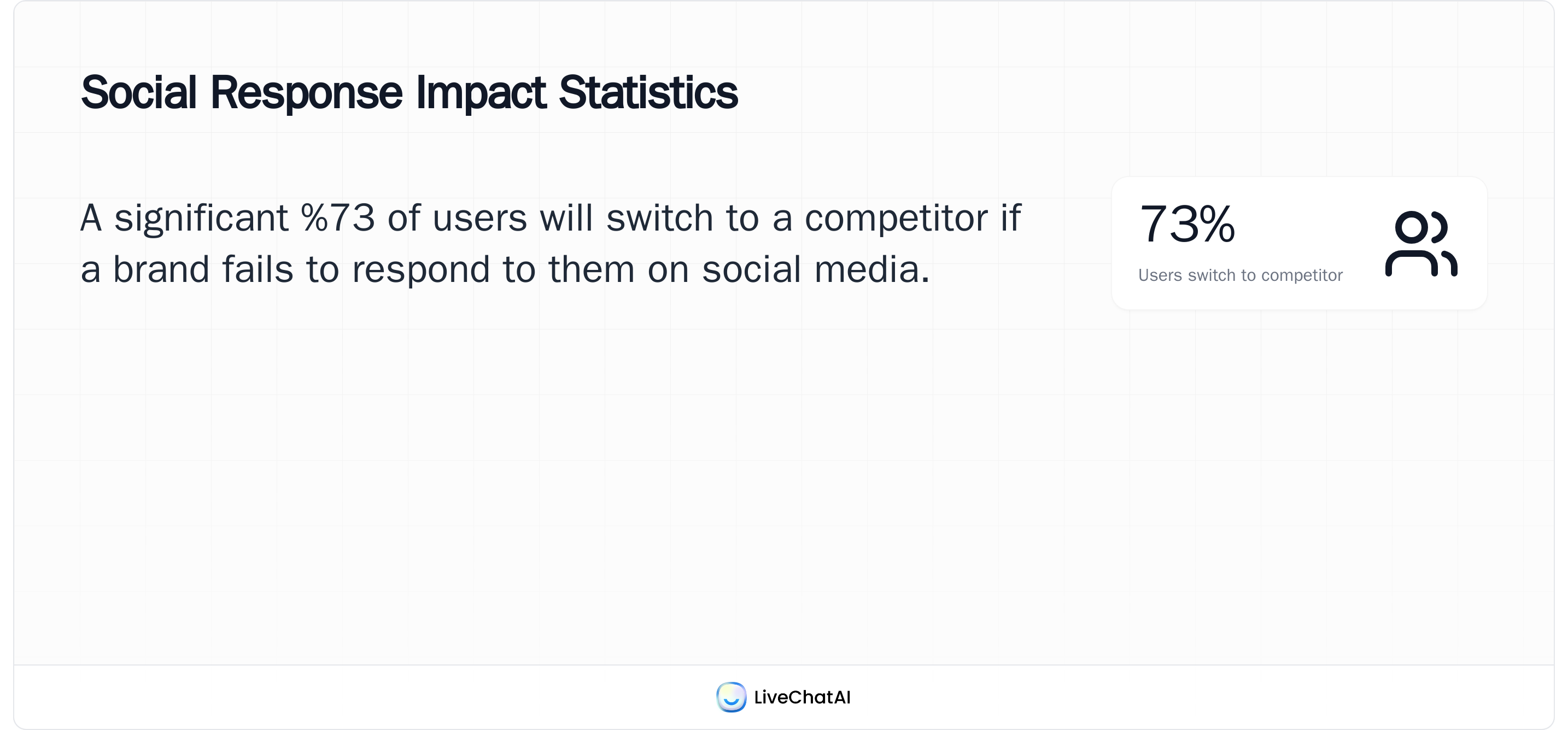
In my view, aiming for under 2 hours on social media is a strong goal. Anything beyond that risks making you look indifferent — especially when customers compare you publicly to faster competitors.
☎️ Phone / Voice Support
When customers call, there’s less tolerance for waiting. The phone is still the channel people use when they need urgency and clarity.
- What customers expect: Many reference a 2-minute wait as the upper limit before frustration sets in. Zendesk’s guidelines position “2 minutes or less” as a standard.

- What “good” means: If callers are waiting more than 3–4 minutes, you’re pushing discomfort.
- Best practice: Use callback options, queue transparency (“You are 2nd in line, estimated wait: 1:30”), or keep messages informative to reduce perceived wait time.
Based on my observations, voice support teams that hover around 90–120 second waits tend to maintain satisfaction. Above that, you start losing patience — even among more tolerant customers.
📱 Messaging Apps (WhatsApp, Messenger, In-App Chat)
Messaging apps have become core support channels, especially in mobile-first markets. For many customers, a message is as instantaneous as asking a friend.
- What customers expect: Anywhere from a few minutes to under 5 minutes is increasingly seen as acceptable. Gorgias, in its benchmarks, suggests “stellar” chat response times under 1 minute; for messaging, sub-minute is ideal.
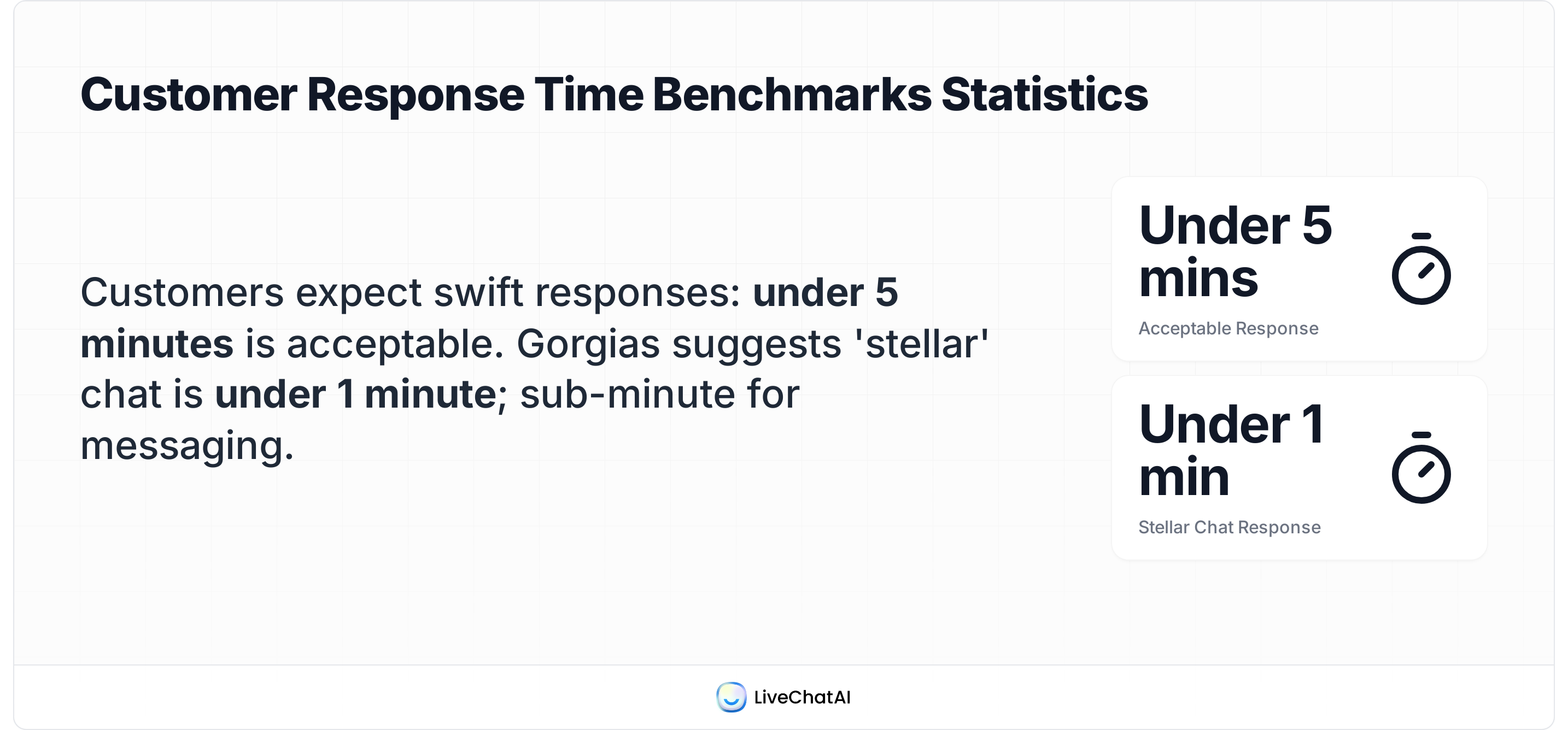
- Reality via automation: Many brands now use bots or hybrid automation to deliver immediate acknowledgments and triage.
- Why it’s appealing: Messaging feels conversational and personal. Fast replies here can build a sense of connection.
In my experience with chat integrations, a messaging app reply within 1–2 minutes is enough to keep customers engaged — even if the full resolution takes more time.
🌍 Variation Across Industries & Demographics
It’s critical to understand that “fast enough” isn’t one-size-fits-all. Context, industry norms, and customer segments shift the bar.
I’ve observed that younger audiences — comfortable with instant messaging and chat — are far less patient. Older or more traditional segments may allow a bit more leeway, as long as the tone is respectful.
Reality Check: Actual Response Times in 2025
No matter how many brands promise “instant support,” the reality in 2025 still tells a different story. From what I’ve seen in my own audits and current benchmark data, the gap between what customers expect and what companies actually deliver is still significant — and in many cases, growing.
Benchmarks from Support Platforms & Surveys
💡 Observation: Live chat and messaging channels come closest to meeting expectations, while email continues to be the slowest by far (Netomi).
According to the latest Sprout Social Index, most customers expect a social media reply within one hour or less, but the average still hovers around 4–5 hours
Meanwhile, data from Zendesk CX Trends 2025 indicates that a “good” first response time for email is under four hours, which only a small portion of companies currently achieve.
From what I’ve observed, the real issue isn’t the first reply — it’s the long pause between acknowledgment and actual resolution. Customers might feel heard initially, but satisfaction drops sharply when updates go silent for hours afterward.
Gaps Between Expectation vs. Reality
According to 2025 data from Help Scout, nearly 60% of customers define “immediate response” as 10 minutes or less.
That means most brands still miss the psychological immediacy window that shapes how customers perceive care and reliability.
But here’s something I’ve learned firsthand: speed isn’t everything.
A 30-second “We’ll get back to you soon” isn’t better than a thoughtful three-minute reply that actually solves the issue. The real goal isn’t just “fast” — it’s fast and meaningful.
Key Takeaway:
Brands that find the balance between automation and authenticity — where AI delivers speed and humans deliver empathy — are the ones customers remember.
AI can set the pace, but it’s empathy that keeps the trust.
AI vs Human Response Times: What the Data Says 🤖 / 👤
I’ve had countless conversations with customer-service teams about this question: “Are bots really faster — and do customers actually like them?”
The short answer? Yes, they’re faster. But whether they make customers happier depends on how they’re used.
Response Latency: Bots vs Humans
From the LivePerson Conversational AI Benchmark 2025, bots handle initial replies 97% faster than humans.
However, data from HubSpot’s 2025 Service Trends shows that satisfaction drops sharply when a bot gives irrelevant or repetitive answers.
In my own testing with hybrid AI + human setups, the sweet spot is a 5-second automated greeting followed by a 1–2 minute human join-in when the issue requires context.
That blend delivers both speed and reassurance — a combination customers instantly feel.
Quality and Satisfaction Trade-offs
Fast responses don’t automatically mean better experiences. In fact, too much automation can backfire.
- According to the IBM, about 58% of customers abandon chat sessions when they realize a bot can’t resolve their issue.
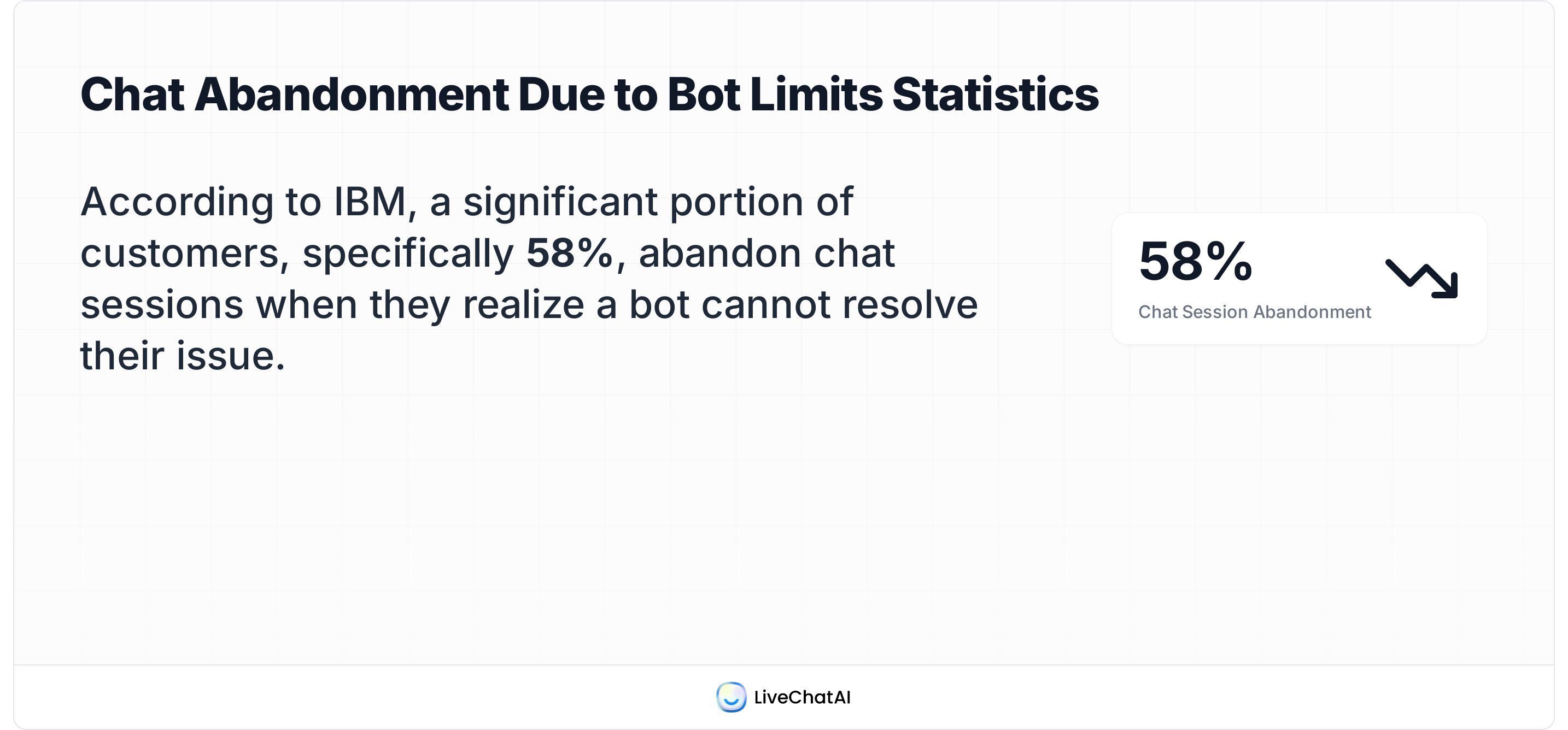
- Meanwhile, Zendesk found that AI + human collaboration improves customer-satisfaction scores by up to 20% compared to AI-only setups.
- From what I’ve seen, customers mainly seek certainty. When bots clearly explain what they can and can’t do, people tend to appreciate the transparency.
Pretending automation is human erodes trust faster than any delay ever could.
Hybrid and Escalation Models
The most effective support teams I’ve worked with in 2025 run on a hybrid orchestration model:
- AI triages instantly — greeting, topic identification, quick help-article suggestion.
- AI summarizes the issue for the agent, including sentiment and intent.
- Human agent joins within 1–2 minutes for nuanced or emotional requests.
When AI handles the routine and preps the context, agents spend more time solving and less time digging.
That’s why I see “AI vs Human” as the wrong question. The real power lies in AI + Human, working together in rhythm.
Limits, Failures, and Safeguards
I’ve also seen where AI falls short — and how small missteps can break trust fast:
- Context loss: Bots sometimes reset when sessions time out, forcing customers to re-explain everything.
- Escalation failures: Poor routing or missing triggers leave users stuck in loops.
- Tone mismatch: Overly formal or repetitive wording makes people feel ignored.
Smart teams prevent these pitfalls with a few simple safeguards:
- Add a visible “Talk to a human” button within 30 seconds.
- Provide agents with AI-generated conversation summaries before handoff.
- Review AI accuracy and escalation logs weekly to catch gaps early.
In my opinion, the true mark of great AI isn’t how fast it replies — it’s how well it knows when to stop and hand things over.
Key Takeaway: AI doesn’t replace human speed — it amplifies it.
Bots win on latency, humans win on empathy. The companies combining both intelligently are already leading in CSAT and cost-efficiency in 2025.
Best Practices & Strategies to Meet Response Time Expectations ⚙️
Over the years, I’ve learned that hitting “fast” response targets isn’t just about hiring more people — it’s about designing a system where speed happens by default.
Below are the strategies I’ve seen work best, both in my own projects and across leading CX operations in 2025.
Set Realistic SLAs — and Communicate Them Clearly
If there’s one rule I never skip, it’s expectation management. Customers forgive a wait if they know how long it’ll be. They only get frustrated when they’re left guessing.
- Define separate Service Level Agreements (SLAs) per channel (chat ≠ email ≠ social).
- Publicly share estimated reply times in your chat widgets or auto-responses.
- Monitor SLA breaches daily — even 10% over target is an early warning sign.
Prioritize & Triage Intelligently
Not every ticket deserves the same clock. The best support systems prioritize by urgency, impact, and intent — not just by “first come, first served.”
- Use AI-powered intent detection to tag urgent vs. low-impact queries automatically.
- Escalate anything tagged as payment, access, outage, or security within minutes.
- Route routine “how-to” or FAQ tickets to self-serve flows instantly.
From my own dashboards, introducing automated triage typically cuts median first-response time by 35–45% within a month.
Use AI as an Assistant — Not a Replacement
I’ve seen teams swing too far both ways: either fully manual or fully automated. The winning formula is AI assisting humans — drafting, summarizing, predicting — not replacing them.
- Let AI auto-draft responses for human review (reduces typing time by 50%).
- Use AI summarization to give agents instant conversation history before they reply.
- Apply predictive routing so tickets land with the best-qualified rep from the start.
The Zendesk CX Trends Report 2025 shows that AI-assisted agents handle 33% more tickets per hour while maintaining higher satisfaction than non-assisted peers.

Optimize Staffing, Schedules & Coverage
Speed suffers most when volume peaks meet empty seats. The answer isn’t always hiring — it’s smart scheduling and coverage planning.
- Analyze ticket volume by hour, weekday, and seasonality to spot true peaks.
- Build micro-shifts or flexible rotations to handle demand surges.
- Consider “follow-the-sun” models for 24/7 chat and messaging coverage.
I’ve helped teams cut backlog spikes by simply re-balancing weekend and late-day coverage — no new hires, just better distribution.
Continuously Measure, Feedback & Improve
What isn’t measured won’t improve. The best support teams run closed feedback loops between agents, data, and customers.
- Track First Response Time (FRT), Resolution Time (RT), and Re-contact Rate weekly.
- Correlate speed metrics with CSAT or NPS — speed only matters if satisfaction stays high.
- Ask frontline agents what slows them down — tool friction often hides behind the numbers.
According to Salesforce’s 2025 State of Service Report, 82% of service leaders who track FRT weekly report year-over-year improvements in both speed and satisfaction.

Key Takeaway: Speed isn’t an accident — it’s a system.
When SLAs are transparent, triage is intelligent, AI supports agents, and metrics drive iteration, response time becomes a competitive advantage rather than a constant fire drill.
Looking Forward: Trends That Will Shape Support Response Times 🔮
Whenever I think about the next wave of customer support, I don’t just look at faster tools — I look at how customer patience, technology, and expectations evolve together.
From what I’ve seen in 2025 so far, we’re moving from reactive speed (replying fast) to predictive speed (solving before they ask). Here’s what’s shaping that shift.
Generative AI & LLM-Powered Support
Large Language Models (LLMs) have changed what “instant” means. Instead of just replying faster, they now anticipate intent, personalize tone, and summarize context for agents in real time.
- Proactive prompts: Tools like OpenAI’s GPT-4 Turbo and Anthropic’s Claude 3 now enable chatbots to predict user intent from partial input and pre-fill answers.
- Dynamic personalization: Responses adjust based on emotion detection and past purchase or ticket history.
In my view, the big leap isn’t in speed alone — it’s in accuracy under pressure. Fast is only impressive when it’s also right.
Predictive & Proactive Support
I’ve always believed the best response time is zero — when you prevent the issue before the customer even contacts you.
That’s exactly where predictive analytics is heading.
- Usage-based triggers: SaaS platforms now flag customers at risk of churn or error before they submit a ticket.
- Device & IoT alerts: In hardware and logistics, proactive chatbots reach out the moment an anomaly is detected.
- Voice of the customer (VoC) analytics: Predictive systems detect negative sentiment trends early, helping CX teams act before reputation damage happens.
Cross-Channel Context & Unified Conversations
The next frontier of response time isn’t speed per channel, it’s context across channels.
In 2025, a customer might start on WhatsApp, follow up on email, and expect you to remember everything. If your systems don’t connect those dots, you’ll never seem fast — no matter how quickly you type.
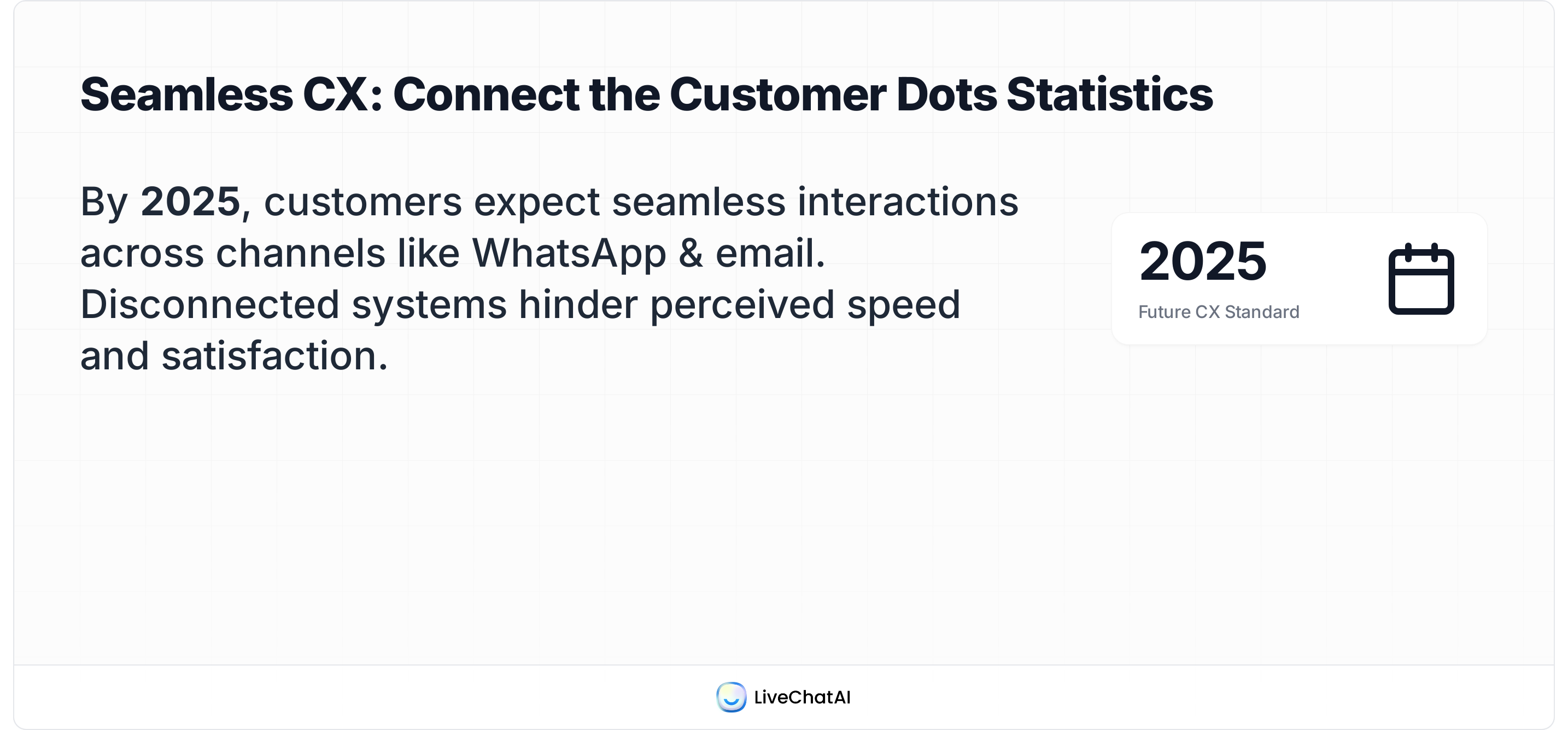
That’s why the trend is toward unified inboxes and CRM-native support that pull every interaction into one thread.
In my experience, context continuity is the hidden multiplier of perceived speed. When customers don’t have to repeat themselves, even a 3-minute response feels instant.
The Psychology of Patience
I find this part fascinating: technology shapes what we think is “reasonable.”
As AI gets faster, customer patience shrinks. That’s not entitlement — it’s conditioning.
- Mobile-first impatience: Users now treat live chat like texting a friend. Delays over 1–2 minutes feel unnatural.
- Time perception bias: According to Harvard Business Review, perceived wait time feels 36% shorter when the user is actively engaged.
- Design empathy: Support UIs that show typing indicators, progress bars, or “we’re reviewing your case” micro-copy keep customers calm during the wait.
To me, this is the new CX frontier — managing emotional latency as carefully as technical latency.
Key Takeaway: The future of response time isn’t just about cutting seconds — it’s about predicting need, preserving context, and designing patience.
As AI becomes proactive and omnichannel memory becomes standard, “waiting for support” will start to feel outdated.
Conclusion & My Final Thoughts 💭
Whenever I look at response time metrics, I remind myself: behind every number, there’s a moment.
A customer waiting.
An agent juggling priorities.
A brand either earning or losing trust — minute by minute.
In my experience, speed isn’t the real challenge anymore; it’s alignment. We already have the tools to respond instantly — AI chatbots, CRM automations, predictive triggers — but too many systems still operate in silos. The teams that win are the ones connecting those dots: combining automation with empathy, analytics with awareness.
Here’s how I see it:
- AI sets the pace. It delivers the speed, the triage, the instant acknowledgment.
- Humans set the tone. They bring empathy, adaptability, and emotional intelligence — the traits that can’t be coded.
- Systems set the standard. Clear SLAs, unified conversations, and data feedback loops turn “support” into an ongoing promise.
If I could leave you with one thought, it’s this:
Fast response isn’t about milliseconds — it’s about meaning. Customers don’t remember how quickly you replied; they remember how clearly you cared.
That’s the difference between a brand that’s available and a brand that’s trusted.
Frequently Asked Questions (FAQ) 💬
1. What is a good average response time for customer support in 2025?
From what I’ve seen across industries, a good average first-response time in 2025 depends on the channel:
- Live chat: under 1 minute
- Social media: within 1 hour
- Email: within 4 hours
- Phone: 2–3 minutes
- Messaging apps (like WhatsApp or Facebook): under 5 minutes
According to Zendesk CX Trends 2025, these benchmarks align closely with customer expectations across most digital touchpoints.
2. How fast do customers expect a response today?
Expectations are shrinking every year. According to Help Scout, around 60% of customers define “immediate” as within 10 minutes or less.
In my experience, this means customers no longer compare you to direct competitors — they compare you to their fastest experience anywhere.
3. Does using AI actually improve response times?
Yes — dramatically. AI chatbots can deliver first responses in under one second, and AI-assisted agents handle up to 33% more tickets per hour.
But the real magic happens in hybrid models, where AI triages and drafts while humans bring empathy and context.
4. How can companies reduce their response times without hiring more agents?
The three levers that work best in my experience are:
- Automated triage (using AI or rule-based routing).
- Unified inboxes that merge all conversations across channels.
- Clear SLAs + visible expectations in chat or email replies.
You can reduce median response times by 30–50% within months simply by removing silos and adding automation at the entry point.
5. What’s the biggest mistake companies make when trying to respond faster?
They chase speed for the sake of speed.
In my experience, the biggest mistake is measuring response time without measuring resolution quality or customer sentiment.
A lightning-fast “we’ll get back to you” doesn’t solve the problem — it just moves it forward.
The goal isn’t to respond first; it’s to respond right and fast.
Check out these blog posts as well:




